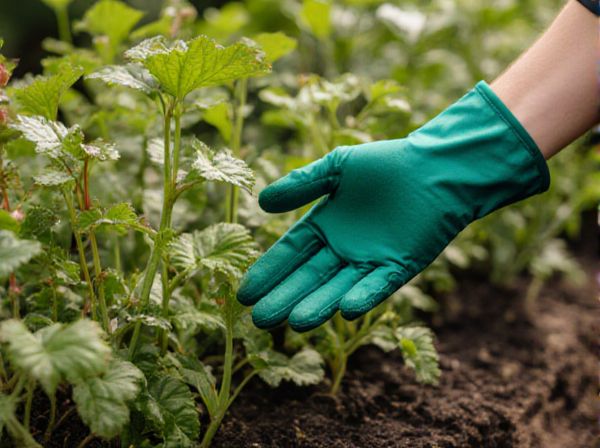
Nitrogen-fixing plants vs synthetic fertilizers Illustration
Nitrogen-fixing plants enhance soil fertility naturally by converting atmospheric nitrogen into forms accessible to crops, promoting sustainable agriculture and reducing environmental impact. Unlike synthetic fertilizers, these plants improve soil structure and support biodiversity without causing harmful runoff or chemical dependency. Integrating nitrogen-fixing species into permaculture systems fosters long-term soil health and resilience.
Table of Comparison
| Aspect | Nitrogen-Fixing Plants | Synthetic Fertilizers |
|---|---|---|
| Source of Nitrogen | Biological nitrogen fixation via symbiotic bacteria (Rhizobium) | Chemically manufactured nitrogen compounds (e.g., ammonium nitrate) |
| Environmental Impact | Enhances soil health; reduces erosion; promotes biodiversity | Can cause soil acidification, water pollution, and greenhouse gas emissions |
| Soil Health | Improves organic matter and microbial activity | May degrade soil structure and microbial diversity over time |
| Cost | Low to no cost after establishment | Recurring purchase and application costs |
| Application Frequency | Perennial or seasonal planting; continuous nitrogen supply | Requires regular reapplication based on crop needs |
| Efficiency | Moderate nitrogen supply, dependent on plant growth and conditions | High immediate nitrogen availability |
| Sustainability | Supports regenerative agriculture and long-term fertility | Non-renewable resource-based; less sustainable |
Understanding Nitrogen Fixation in Permaculture
Nitrogen-fixing plants, such as clover, alfalfa, and legumes, play a crucial role in permaculture by naturally enriching the soil with nitrogen through symbiotic bacteria in their root nodules, enhancing soil fertility sustainably. Unlike synthetic fertilizers that provide immediate nitrogen but can disrupt soil microbiomes and contribute to pollution, nitrogen-fixing plants improve soil structure and promote long-term ecological balance. Integrating nitrogen-fixing plants into crop rotations or polycultures reduces dependency on chemical inputs and supports resilient agroecosystems.
The Science Behind Nitrogen-Fixing Plants
Nitrogen-fixing plants, such as legumes, form symbiotic relationships with Rhizobium bacteria in root nodules, converting atmospheric nitrogen (N2) into ammonia (NH3) usable by plants through biological nitrogen fixation. This natural process enhances soil fertility by increasing organic nitrogen content without the environmental drawbacks associated with synthetic fertilizers, which rely on the energy-intensive Haber-Bosch process to produce ammonia. Research shows nitrogen-fixers improve soil microbial diversity and sustain long-term nitrogen availability, reducing dependence on chemical inputs in sustainable permaculture systems.
Types of Nitrogen-Fixing Plants for Your Garden
Nitrogen-fixing plants such as clover, lupines, and alfalfa enrich soil fertility naturally by converting atmospheric nitrogen into forms usable by plants, promoting sustainable gardening. Leguminous trees like black locust and acacia also improve soil nitrogen content while providing shade and organic matter. Integrating these nitrogen-fixing species reduces dependence on synthetic fertilizers, enhancing soil health and boosting plant growth in permaculture gardens.
Synthetic Fertilizers: Composition and Application
Synthetic fertilizers primarily contain nitrogen, phosphorus, and potassium in concentrated forms such as ammonium nitrate, urea, and superphosphate, designed for rapid nutrient delivery to plants. Their application involves precise dosage and timing to maximize crop yield and minimize nutrient runoff, often requiring specialized equipment for soil incorporation or foliar spraying. Despite efficiency, overuse can lead to soil degradation, groundwater contamination, and disruption of natural nitrogen cycles, contrasting with the sustainable nutrient supply from nitrogen-fixing plants in permaculture systems.
Comparing Soil Health: Plants vs Synthetic Fertilizers
Nitrogen-fixing plants enhance soil health by naturally replenishing nitrogen levels through symbiotic relationships with rhizobia bacteria, improving soil structure and microbial diversity. Synthetic fertilizers provide immediate nitrogen boost but often lead to soil acidification, reduced microbial activity, and long-term nutrient imbalances. Using nitrogen-fixing plants promotes sustainable soil fertility and resilience, supporting ecosystem biodiversity and reducing dependence on chemical inputs.
Environmental Impact: Sustainability of Each Approach
Nitrogen-fixing plants enrich soil naturally by converting atmospheric nitrogen into bioavailable forms, enhancing soil fertility without harmful residues or energy-intensive processes. Synthetic fertilizers, derived from industrial processes like the Haber-Bosch method, contribute to greenhouse gas emissions, soil degradation, and water pollution through nitrogen runoff and leaching. Prioritizing nitrogen-fixing plants supports sustainable agriculture by promoting soil health, reducing carbon footprint, and minimizing ecological disturbances compared to conventional fertilizer use.
Cost Analysis: Natural Nitrogen vs Chemical Fertilizers
Nitrogen-fixing plants such as clover and legumes reduce dependency on costly synthetic fertilizers by naturally enriching soil nitrogen levels, lowering overall input expenses for sustainable farming. Synthetic fertilizers require significant financial investment for purchase and application, often leading to increased long-term costs due to soil degradation and environmental impacts. Incorporating nitrogen-fixing plants supports cost-effective nutrient management by enhancing soil fertility through biological processes without heavy reliance on chemical inputs.
Ecosystem Benefits of Nitrogen-Fixing Plants
Nitrogen-fixing plants enhance soil fertility by naturally converting atmospheric nitrogen into bioavailable nutrients, reducing the need for synthetic fertilizers that can disrupt microbial soil communities. These plants support biodiversity by creating habitats for beneficial insects and microorganisms, promoting balanced ecosystem functions. Their ability to improve soil structure and water retention further contributes to sustainable, resilient agricultural systems.
Potential Drawbacks and Challenges
Nitrogen-fixing plants, while sustainable and eco-friendly, can face challenges such as slower nutrient release compared to synthetic fertilizers, leading to potential initial deficiency in fast-growing crops. These plants may also require specific soil conditions and symbiotic bacteria, limiting their effectiveness in certain environments. Synthetic fertilizers provide immediate nitrogen availability but pose risks of soil degradation, water pollution, and disrupting natural microbial ecosystems.
Integrating Nitrogen-Fixers into Permaculture Design
Integrating nitrogen-fixing plants such as legumes and clover into permaculture design enhances soil fertility naturally by converting atmospheric nitrogen into bioavailable forms, reducing dependence on synthetic fertilizers that can degrade soil health and contribute to environmental pollution. These plants improve long-term sustainability by promoting soil microbial activity, increasing organic matter, and supporting diverse plant ecosystems. Strategic placement of nitrogen-fixers within crop rotations or polycultures maximizes nutrient cycling efficiency and stabilizes yields in permaculture systems.
Nitrogen-fixing plants vs synthetic fertilizers Infographic

 gardendif.com
gardendif.com